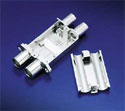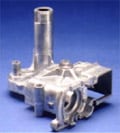Die-casting is similar to permanent mold casting except that the metal is injected into the mold under high pressure of 10-210Mpa (1,450-30,500) psi . This results in a more uniform part, generally good surface finish and good dimensional accuracy, as good as 0.2 % of casting dimension. For many parts, post-machining can be totally eliminated, or very light machining may be required to bring dimensions to size.

- In a cold chamber process, the molten metal is ladled into the cold chamber for each shot. There is less time exposure of the melt to the plunger walls or the plunger. This is particularly useful for metals such as Aluminum, and Copper (and its alloys) that alloy easily with Iron at the higher temperatures.
- In a hot chamber process the pressure chamber is connected to the die cavity is immersed permanently in the molten metal. The inlet port of the pressurizing cylinder is uncovered as the plunger moves to the open (unpressurized) position. This allows a new charge of molten metal to fill the cavity and thus can fill the cavity faster than the cold chamber process. The hot chamber process is used for metals of low melting point and high fluidity such as tin, zinc, and lead that tend not to alloy easily with steel at their melt temperatures.
Die casting molds (called dies in the industry) tend to be expensive as they are made from hardened steel-also the cycle time for building these tend to be long. Also the stronger and harder metals such as iron and steel cannot be die-cast.
Common Alloys in Die Casting
Aluminum, Zinc and Copper alloys are the materials predominantly used in die-casting. On the other hand, pure Aluminum is rarely cast due to high shrinkage, and susceptibility to hot cracking. It is alloyed with Silicon, which increases melt fluidity, reduces machinability. Copper is another alloying element, which increases hardness, reduces ductility, and reduces corrosion resistance.
Aluminum is cast at a temperature of 650 Deg C (1200 Deg F). It is alloyed with Silicon 9% and Copper about 3.5% to form the Aluminum Association 380 alloy (UNS A03800). Silicon increases the melt fluidity, reduces machinability, Copper increases hardness and reduces the ductility. By greatly reducing the amount of Copper (less than 0.6%) the chemical resistance is improved; thus, AA 360 (UNS A03600) is formulated for use in marine environments. A high silicon alloy is used in automotive engines for cylinder castings, AA 390 (UNS A03900) with 17% Silicon for high wear resistance. Common aluminum alloys for die casting are summarized as follows:
| Material | Silicon | Copper | Tensile Strength MPa (ksi) | Properties |
|---|---|---|---|---|
| AA 380 (UNS A03800) | 8.5 % | 3.5 % | 324 (47) | Fair easy to fill |
| AA 384 (UNS A03840) | 11 % | 4 % | 331 (48) | Easy to fill |
| AA 386 (UNS A03860) | 9.5 % | 0.6 % | 317 (46) | Good corrosion resistance |
| AA 390 (UNS A03900) | 17 % | 4.5 % | 283 (41) | Good wear resistance |

Copper alloys are used in plumbing, electrical and marine applications where corrosion and wear resistance is important.
Minimum wall thicknesses and minimum draft angles for die casting are:
| Material | Min. Thickness mm (in) | Min. Draft Angle (�) |
|---|---|---|
| Aluminum alloys | 0.9 mm (0.035 in) | 0.5 |
| Zinc alloys | 0.6 mm (0.025 in) | 0.25 |
| Copper alloys (Brass) | 1.25 mm (0.050 in) | 0.7 |
Die-castings are typically limited from 20 kg (55 lb) max. for Magnesium, to 35 kg (77 lb) max. for Zinc. Large castings tend to have greater porosity problems, due to entrapped air, and the melt solidifying before it gets to the furthest extremities of the die-cast cavity. The porosity problem can be somewhat overcome by vacuum die casting
From a design point of view, it is best to design parts with uniform wall thicknesses and cores of simple shapes. Heavy sections cause cooling problems, trapped gases causing porosity. All corners should be measured by the radius generously to avoid stress concentration. Draft allowance should be provided to all for releasing the parts-these are typically 0.25mm to 0.75mm per side depending on the material.


